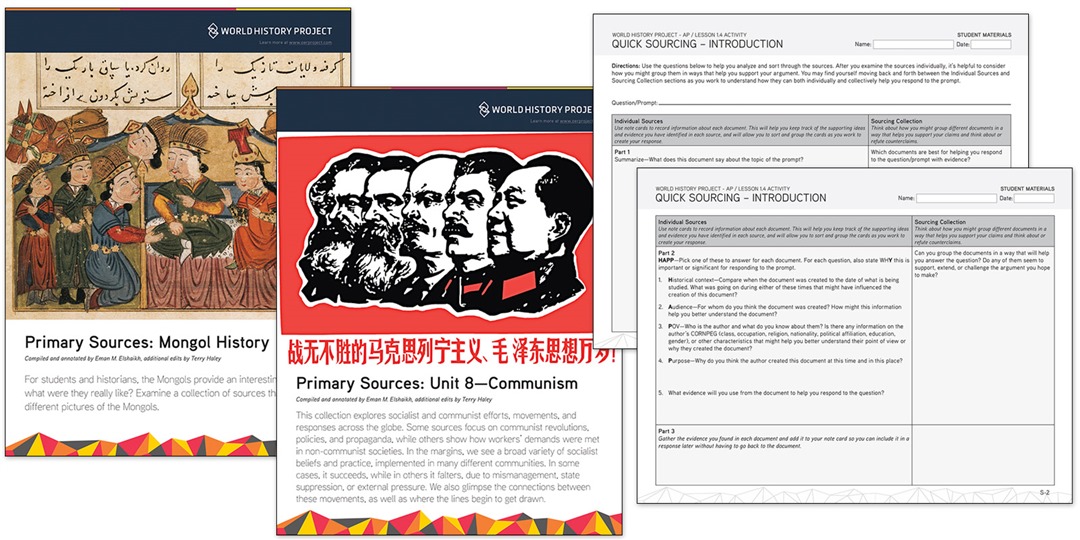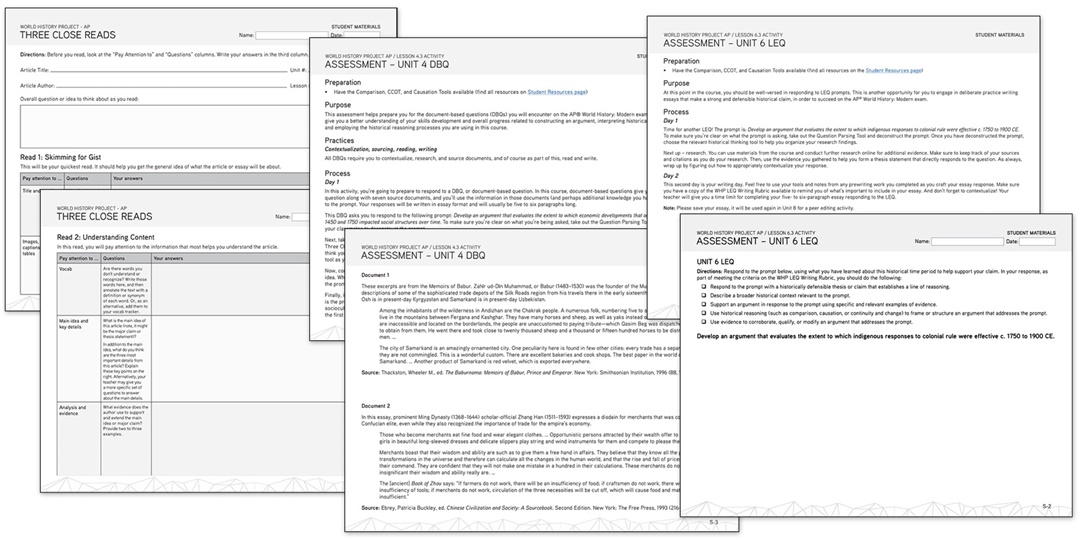By Bridgette Byrd O’Connor, OER Project Team
It’s here; it’s finally here—the complete launch of World History Project AP® (WHP AP)!
As a former AP teacher, I know how difficult it is to find the right text for your AP class—that is, if you’re lucky enough to be in on the textbook selection process. Which college-level text is going to engage your students, present the necessary content, skills, and primary source excerpts, yet not be at a level that’s completely over their heads? Then comes the agonizing process of crafting and submitting your AP syllabus for the audit process. Before College Board allowed you to select an approved syllabus to adopt, I knew teachers who submitted their syllabi numerous times before they were approved—it was a nerve-racking process. And all that comes before you’ve even had your first class of AP students! Well, fear no more, the OER Project’s WHP AP course checks all the boxes.
 The flavors of WHP
The flavors of WHP
The OER Project offers many different history courses, including three versions of the World History Project (Origins, 1200 to the Present, and 1750 to the Present). Why so many? And why add yet another “flavor” to our course offerings? Well, we created WHP knowing that each state, and sometimes different school districts within a state, have their own social studies standards with different periodizations. We wanted to make sure that we created courses that covered these standards, and by offering different periodizations we’re able to help teachers in all 50 states. The next logical step was to create a WHP flavor that aligned with the AP® World History: Modern Course and Exam Description (CED) so that AP teachers and their students would have access to a high quality, free, college-level course that would prepare students for the AP exam.
 A selection of WHP AP articles
A selection of WHP AP articles
The WHP AP course includes college-level articles written by historians in an engaging way that help students learn the content necessary to perform well on the AP® exam. The articles also help students understand that the past informs the present and prepares us for the future. Making those connections between AP content and a usable history means that students will also be prepared for life beyond the exam, which, I think we can all agree, is more important for our students than an exam.

The course also features numerous videos—some from Crash Course and Khan Academy, with the majority created by the OER Project team. From content deep dives to videos filmed on-location around the world, the videos offer a different means of accessing the course content. We’re also excited to launch a new series of videos created just for WHP AP. These unit overview videos, which kick off each unit, give students a preview of what they’ll be learning. These videos begin with an illustrative example that is interwoven throughout the video, highlighting connections to both the content and themes for that unit. (Note that we’re just finishing up production on these new videos. Units 1-4 are available right now, and units 5-9 will be published by early August!)

A selection of WHP AP activities
The activities, which align with the AP historical-thinking skills and reasoning practices, provide students with scaffolded ways to learn how to make historical comparisons, analyze causes and consequences, evaluate continuities and changes over time, source primary and secondary source documents, contextualize, and claim test the information they encounter in their history courses and in the real world.
 Primary source articles and the Quick Sourcing Tool
Primary source articles and the Quick Sourcing Tool
Did we mention that we have more than 20 primary-source collections in the course? Each collection was curated to align with the AP historical-thinking skills of claims and evidence in sources and sourcing and situation. We’ve also developed—with the help of our AP pilot teachers—a Quick Sourcing Tool, which allows students to work on sourcing documents quickly and group them together to answer a guiding question or prompt that is aligned with the AP® CED.
 Three Close Reads worksheet (left), DBQ (middle), LEQ (right)
Three Close Reads worksheet (left), DBQ (middle), LEQ (right)
In addition, we maintain the emphasis on reading and writing that is key to all our courses. Using the Three Close Reads strategy, AP students learn how to carefully skim, read, and make connections across lessons and the course as a whole. Completing the WHP AP writing progression will help your students prepare for the document-based questions (DBQs) and long-essay questions (LEQs) that close each unit of the course. And this will all, of course, help prepare students for the AP® World History: Modern exam in May.
 A selection of graphic bios
A selection of graphic bios
At the OER Project, we work to create curricula that are adaptable and current, and WHP AP is just that. As we do with all of our courses, we listen to feedback from WHP AP teachers, make improvements to the course, and update when new research and evidence is uncovered. We also believe that student engagement is crucial, and this is reflected in our materials. In particular, our graphic biographies tell the stories of individuals throughout history that are often overlooked. Students can use these to question the broad global and regional narratives in the course. And we’ve included fun activities such as the Silk Roads Simulation, Cold War Crisis, and Contagion!
The OER Project also offers some fantastic professional development including onboarding and info sessions, live sessions, our asynchronous Teaching World History AP course (coming later this summer!), and a thriving community of teachers, who are always willing to help. We’d love to know what you think about the course. Feel free to share your questions, ideas, and your go-to lessons in our WHP AP Teacher Community.
About the author: Bridgette Byrd O’Connor holds a DPhil in history from the University of Oxford and taught the Big History Project and World History Project courses and AP US government and politics for 10 years at the high-school level. In addition, she’s been a freelance writer and editor for the Crash Course World History and US History curricula. She’s currently a content manager for the OER Project.
 For full access to all OER Project resources AND our amazing teacher community,
For full access to all OER Project resources AND our amazing teacher community, 
-

Monica Bond-Lamberty
-
Cancel
-
Up
0
Down
-
-
Reply
-
More
-
Cancel
Comment-

Monica Bond-Lamberty
-
Cancel
-
Up
0
Down
-
-
Reply
-
More
-
Cancel
Children